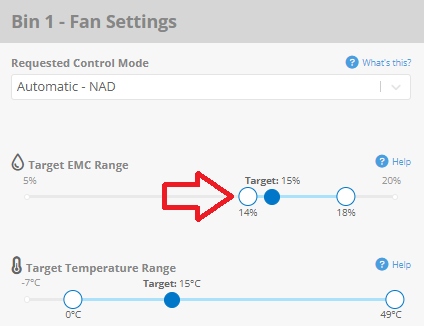You can, however it can at times be not cost effective or efficient, and it depends entirely on ambient conditions. Even with the risks present, if it is done correctly, rehydrating your grain mass may yield value.
How?
If you want to set up your OPI BLUE system to re-hydrate your grain mass, you need to set up your fan control in NAD mode with a target EMC and EMC range set so that it only runs the fans when moist air is available to condition the grain mass.

For example, if you have corn that is dry, say 13.5%, and you want to condition it to 15% then the range set in the above screenshot would make it so that your fans would run at almost any temperature, but only during times when the EMC was 14% to 18%, making it so that only moist air was getting blown into the grain mass. NOTE: This is only an example and should not be taken as actual advise for your specific system.
Risks?
As stated previously, re-hydrating your grain can be not cost effective or efficient, and if conditions are not right, then you will have little to no success. The reasons that it can be not cost effective or efficient are that it takes approximately three times the amount of fan run time to hydrate grain as it does to dry grain an equivalent amount of moisture. Since you are running your fans so much more to re-hydrate, it costs more money to run them to condition the grain, making your return on investment much lower.
Additionally, if you are rehydrating certain grains like beans, there is an expansion risk present as well. For example, if you have a full bin of dry beans and you are looking to re-hydrate these beans, you will need to make sure you are not going to stress the bin due to expansion of the commodity. In this case it might make sense to remove some of the commodity to allow for some room to expand as you re0hydrate.
What can I do instead?
If it is possible, you should condition your grain in the fall months after harvest to temperature and moisture content levels that are conducive to long term storage, and store the grain at those conditions. That way, when you take your grain to market you can do so without re-hydrating the grain mass.
